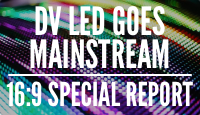
Green Signage May Be A Very Active Discussion Point in Europe, But It Barely Comes Up In North America
May 28, 2024 by Dave Haynes
This is a retail display totem made of wood – put together by the Dutch digital signage solutions provider First Impression and shown last week in Munich at Digital Signage Summit Europe – one of several so-called “green signage” products and solutions highlighted at the event.
The company is making it available to customers as a demonstration of sustainability, but is also offering to provide the production/manufacturing drawings to other companies, at no charge.
It’s one indicator of the wildly different perspectives and approaches to green issues between the European and North American digital signage and proAV communities. In Europe, sustainability is front and center in discussions and part of Requests For Proposals in large projects. In Canada and particularly in the US, it’s not even a thing. It doesn’t come up.
One of the panels I moderated last week at the conference was focused on the North American market, and its differences with Europe.
“If you’re in the US market, and the company tends to be more global, there are a lot more efforts going on around ESG (environmental, social, and governance) and sustainability. And you know, getting to net zero and things like that, that are bold statements that global companies that are in North America are making. But for a lot of North America-specific companies, that don’t have a big global footprint, you’re just not seeing that as a major priority,” Johanny Payero, the US-based Director of Global Advanced Solutions Marketing for Lenovo, said in the panel.
“It’s not even a question we’ve seen in a tender in the last three years,” added Rick Mills, CEO of Creative Realities.
In Las Vegas, in a couple of weeks, some of the hardware manufacturer stands at InfoComm may have references to green initiatives like e-paper, and may show how they are reducing packaging for shipping and reducing simple things like the amount of ink on cardboard boxes, but things like waste reduction and energy usage are not likely to have much profile.
The show is operating in a city that is all about visual noise and scale, and a walk down the strip will take you past casinos where the air conditioning is blasting inside but the entry doors are wide open to the sidewalks. Las Vegas DOES have a lot of water use initiatives, but that’s because its primary water source – Lake Mead – has looked for several years like a bathtub with a leaky drain plug. They had no choice BUT to do things like have resort property water treatment plants.
The main activities in addressing green signage are:
- Reducing energy consumption;
- Reusing hardware;
- Recycling old components.
We’ve seen initiatives in North America and beyond emerge like Chrome OS Flex that can extend the life of PCs by shifting them from Windows to Google’s cloud system, and BrightSign Offering A Sustainability-Focused Trade-In Incentive Program For End Of Life’d Players. Several manufacturers, like PPDS and NEC Sharp, also now have e-paper displays.

The BIG one that should be getting attention among operators of large scale networks and large format ad display screens is energy consumption. Consumers have been conditioned to understand that LED technology greatly reduces energy requirements when compared to older lighting technologies. So … LED = energy friendly. But less understood is that LED displays have thousands or millions of little lights, that may not on an individual basis demand much power, but as an aggregate, use a LOT. While operators may be largely oblivious to the green implications, they do tend to look at operating costs, and ways to reduce them (like lowering energy bills).
One of the discussions last week at the Munich conference got into the weeds of underlying LED display technologies like flip chip and Chip On Board, which in both cases are reducing energy demands. At the conference’s micro trade show, some display companies had real-time energy meters showing what their displays were drawing.
So the industry is moving in a green direction, regardless of individual company efforts. But European companies coming to North America for InfoComm, touting their efforts in green signage to potential partners and customers, might get a lot of blank looks.
If you want to read more about what’s happening in Europe, this is a great resource put together and updated by the invidis team.




That’s because there is NOTHING ‘green’ about digital signage. You can mitigate power consumption a bit, and epaper is getting better, but a QR code and a Smartphone … now there’s something green… oh wait, never mind that…not green either.
(And we have been in the business for 25 years)
and this kind of attitude is a huge roadblock to any hope of bringing down the environmental costs of digital signage.